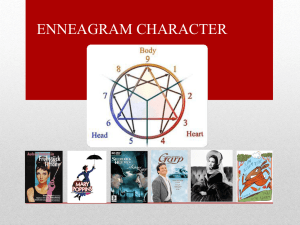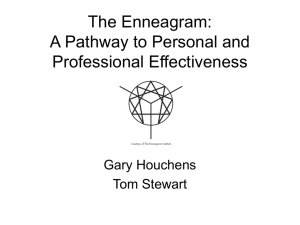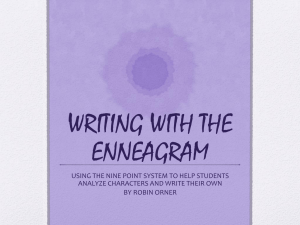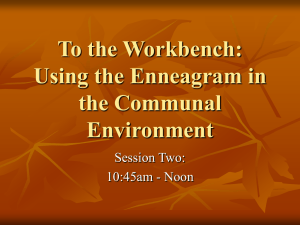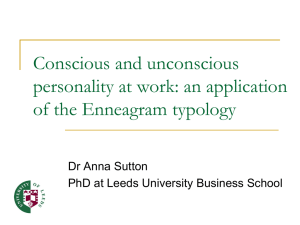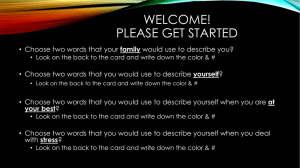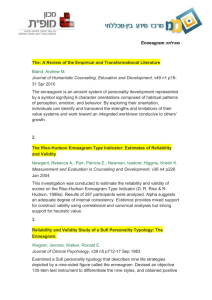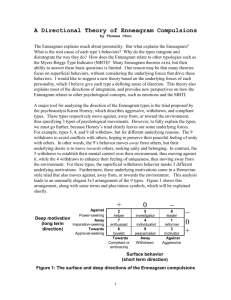Enneagram Session #1
advertisement
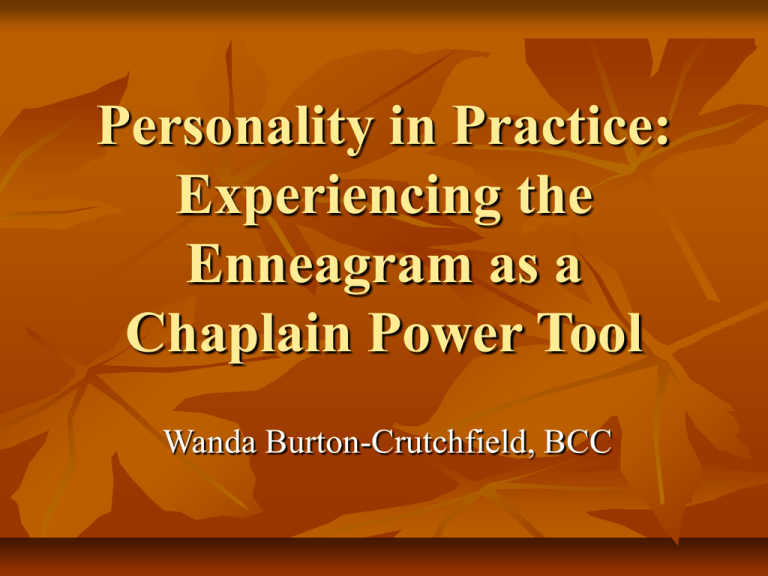
Personality in Practice: Experiencing the Enneagram as a Chaplain Power Tool Wanda Burton-Crutchfield, BCC Honing our Emotional Intelligence: Approaching the Enneagram for Self-Reflection Session One: 9:15am - 10:30am Foreword/ Disclaimer So, Who are the Experts? Ginger Lapid-Bogda, Ph.D. Bringing Out the Best in Yourself at Work: How to Use the Enneagram System for Success. New York: McGraw-Hill, 2004. Don Richard Riso and Russ Hudson. Discovering Your Personality Type, Revised and Expanded. Boston: Houghton Mifflin Company, 2003. Honing Our Emotional Intelligence What is Emotional Intelligence? It has two different yet interconnected components Intrapersonal-- “The ability to know oneself accurately and to use that knowledge to operate successfully in life” Interpersonal-- “The ability to understand and work well with others” (Lapid-Bogda, xvi) Honing Our Emotional Intelligence The Enneagram is a powerful tool to develop emotional intelligence. We can use the Enneagram to Know Ourselves Better Have Compassion for Others Work Effectively in a Communal Environment Lapid-Bogda Honing Our Emotional Intelligence “Understanding the Enneagram is like having a pair of special glasses that allows us to see beneath the surface of people with special clarity: we may in fact see them more clearly than they see themselves” (Riso and Hudson, 3). Exploring the Enneagram The WORD--Greek Ennea--Nine Gram--Something written or drawn It is a nine-points model. The Enneagram is a geometric figure that delineates nine basic personality types of human nature and their complex interrelationships. Exploring the Enneagram Origins No one knows the precise origins. Roots are in Asia and the Middle East. Suspect that the idea/ typology/ was used several thousand years ago. Exploring the Enneagram Origins Brought to the attention of the modern world by GreekArmenian spiritual teacher, George Ivanovitch Gurdjieff, in early 1900s Current typology was developed by Oscar Ichazo of the Aria school of self-realization in 1950s and 60s (using mystical Judaism and Christianity) Attempting to integrate ancient philosophical ideas with empirical observations Exploring the Enneagram The descriptions are universal and apply equally to males and females. The Enneagram uses numbers to designate the types in an attempt to be value neutral-imply a range of attitudes without designating it as positive or negative. The numerical ranking is not significant. Larger numbers are not more valuable than smaller ones. Exploring the Enneagram People do not change from one basic type to another. Not everything in a type’s description will apply all the time because we fluctuate constantly among healthy, average, and unhealthy traits. No type is inherently better or worse than any other. Some types may be more desired by a particular culture or group. Exploring the Enneagram The Nine Enneagram Styles represent nine distinct habits of Thinking Feeling Taking action Nine Unique personal and spiritual paths Exploring the Enneagram The Enneagram describes Nine basic personality types found in human nature that are “all equally useful and valid and have something necessary to contribute to a thriving, balanced world” (Riso/Hudson, 5). Exploring the Enneagram We can find ourselves reflected in the whole of it. The whole Enneagram is within us. The Nine are metaphors for the various psychological functions operating in each of us. Inborn--temperament Heredity and childhood experiences shape us as well. We use the strengths and limitations of our temperaments to cope with the stresses in our environment. Exploring the Enneagram Each of us has one dominant type. Default setting Motivational core Driving our ego agendas Enneagram style remains the same throughout one’s lifetime. Characteristics may soften or become more pronounced as we grow and develop. Our core pattern is naturally linked to four others, so two or three types may seem to match. Personality in Practice The Enneagram helps people recognize and understand overall patterns in human behavior (Riso/Hudson, 5). External behaviors Underlying attitudes One’s characteristic sense of self Conscious and unconscious motivations Emotional reactions Defense mechanisms Object relations What we pay attention to Our spiritual barriers and potentials Personality in Practice “Always remember that the Enneagram does not put you in a box--it shows you the box you are already in (but don’t know it) and the way out!” Riso and Hudson Personality in Practice The Enneagram is the “key that can open the door to a deep understanding of the self and the connections among personality, psychological development, and spiritual transformation.” Lapid-Bogda Personality in Practice Spiritual as well as Psychological Foundation Psychological growth = Ability to Function more effectively Spiritual growth = Acceptance of self, compassion for others Personality in Practice We have two selves Automatic, unconscious Secondary that can watch the mechanics of one’s own mind Through the Enneagram we Discover our Type Learn to recognize and relax the personality patterns that do not bring out our best Helen Palmer (LapidBogda’s teacher) Personality in Practice “Our personalities are based primarily on repetitive habits and patterns” (Riso/Hudson, 8). Personality is not all of who we are but the “filter” that affects the way we see and interact with our world. We study the Enneagram to identify the “chief features and barriers of our psychic landscape” so that we might “prepare for a more profoundly direct and spiritual relationship with reality” (Riso-Hudson, 8). Personality in Practice The Key to Transformation… Lies in our ability to be present To abide in the here and now, with our minds, hearts, bodies, and spirits fully engaged Our personality is not at all interested in the here and now. Personality constantly draws us somewhere else--habitual thoughts, emotional reactions, fantasies about the future, and old stories about who we are and what others have done to us cloud our awareness. Don Riso and Russ Hudson Personality in Practice This work is perfect chaplaincy work. Finding ways to awaken our true condition Once awake, being mindful of “the siren calls of personality” (Riso/Hudson, 9) Possess a capacity to bring a non-judgmental awareness to our own reactivity Personality in Practice We are on a journey to discover a self that is not conflicted, self-deluding, or fearful. Once we discover the mechanical aspects of temperament--automatic, reactive, and defensive patterns--we are less controlled by them. Personality in Practice CAUTION: The Enneagram can become another label through which we hide. We might find our type but go no further. Obstacle to growth We need to make room for grace. At our deepest, we are more than our personality. Personality in Practice CAUTION: Exploring the Enneagram is not about “fixing” ourselves but gaining access to our higher essential qualities. Acceptance Love Authenticity Forgiveness Compassion Courage Joy Strength Presence Gratitude Personality in Practice “The Enneagram takes us to the threshold of spirit and freedom, love and liberation, selfsurrender and self-actualization. Once we have arrived at that uncharted land, we will begin to recognize our truest self, the self beyond personality, the self of essence. That self, of course, cannot be tested by a questionnaire, but only by life itself.” (Riso/ Hudson, 11) Moment for Reflection Credits Ginger Lapid-Bogda, Ph.D. Bringing Out the Best in Yourself at Work: How to Use the Enneagram System for Success. New York: McGraw-Hill, 2004. Don Richard Riso and Russ Hudson. Discovering Your Personality Type, Revised and Expanded. Boston: Houghton Mifflin Company, 2003. “Knick Knack.” PIXAR Short Films Collection. Pixar Animation Studios, 1989.
